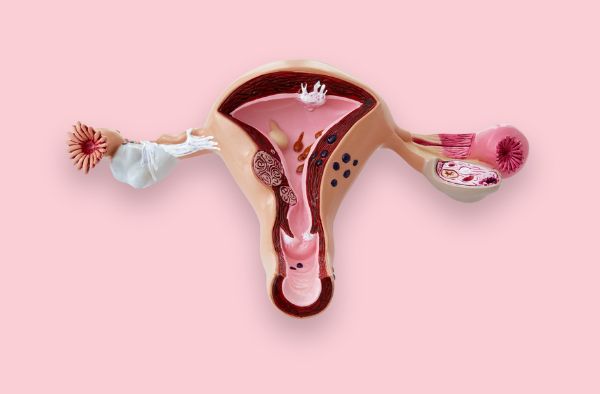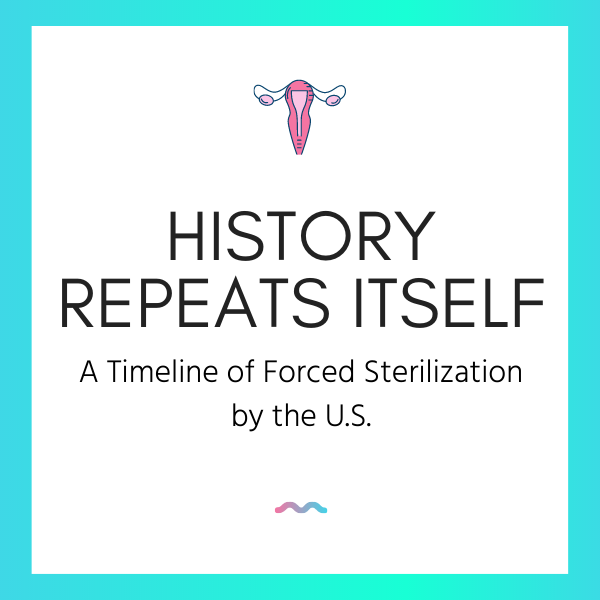It was recently revealed that Dr. Mahendra Amin, a gynecologist working with the Irwin County Detention Center in Georgia, was allegedly performing hysterectomies on Spanish-speaking female immigrants who did not fully understand the procedure — let alone why it was being performed on them.
These allegations came to light after several immigration rights advocacy groups filed a complaint against the center on behalf of whistleblower Dawn Wooten, who had worked as a nurse there for three years.
In addition to bringing our attention to the person she referred to as the “Uterus Collector,” Wooten also revealed that the center was underreporting cases of COVID-19, knowingly placing staff and detainees at risk of contracting the virus, neglecting medical complaints, and more.
These allegations are disturbing, yes.
But they’re only the most recent example of the racially-motivated medical abuse that colors U.S. history.

Sterilization Abuse and Our Relationship with Eugenics
Compulsory (or forced) sterilization is when a woman is sterilized without her knowledge, or when she is coerced or deceived into giving her consent for a sterilization procedure such as a hysterectomy or a tubal ligation. Generally acknowledged now as an act of medical abuse, it’s nevertheless an act that has run rampant throughout this country’s history, and that is tied directly to an early embrace of the eugenics movement.
It was 1883 when Sir Francis Galton first used the term “eugenics” to explain the theory of biological determinism. This theory posits that our abilities are passed down genetically and that, through selective breeding, the human race can improve its overall quality.
Galton wasn’t an outlier in these beliefs. His research was well funded and a number of feminist reformers backed his agenda, including (as we all know by now) Margaret Sanger, the founder of Planned Parenthood. In addition to believing that birth control could be used to prevent unwanted children from being born to disadvantaged families, Sanger also preached the sterilization of those who might pass on mental disorders or serious physical defects.

Forced Sterilization as “Population Control”
But before Margaret Sanger published her pamphlets on the glories of eugenics, the United States employed forced sterilization in Puerto Rico, presumably as a form of population control.
The United States assumed governance of Puerto Rico in 1898 and, from the beginning, claimed that overpopulation of the island was the primary cause of poverty there. It was suggested that if only population growth were slowed, the standard of living would improve.
And so, poor women were targeted for sterilization and pharmaceutical experimentation and, in 1937, the U.S. passed Law 116, which made its population control efforts official. Doctors went door to door, performing sterilization procedures for free. The women targeted by these efforts were not provided with information about — or access to — alternative forms of contraception, and they were left in the dark as to the repercussions of these irreversible procedures.
Law 116 was not repealed until 1960 and a 1965 survey of Puerto Rican residents found that about one-third of all Puerto Rican mothers, ages 20–49, were sterilized.

Sterilization Programs Across the United States… and Abroad
Forced sterilization programs were not restricted to Puerto Rico. As early as 1907, public policy gave the U.S. government the right to sterilize “unwilling and unwitting people,” as they were considered incapable of managing their own reproductive health. These federally-funded sterilization programs were eventually adopted in 32 states across the mainland and led to more than 60,000 sterilizations. Many of those sterilized were targeted due to mental or physical disabilities, or because they belonged to socially disadvantaged groups.
Some states set up Eugenics Boards, which reviewed petitions from government and private agencies seeking to sterilize the poor, unwed, and mentally disabled. North Carolina alone sterilized over 7,600 individuals between the 1930s and 1970s, and their sterilization law remained in place until 1973. It wasn’t until April 4, 2003, that the North Carolina Senate voted unanimously to overturn it.
The United States was so darn good at coercing marginalized populations into forced sterilization that their eugenicist practices inspired those of other countries, including — most notably — Germany. When eugenics programs in the U.S. were in full swing, America’s elite often described those they considered biologically inferior as “bacteria,” “vermin,” “mongrels” and “subhuman,” language we’ve seen before in our classroom lessons on the Nazis. And in fact, a young Adolf Hitler followed the practices of the United States closely, even sending fan letters to American proponents of eugenics, including Leon Whitney, president of the American Eugenics Society, and Madison Grant, author of The Passing of the Great Race. In his letter to Grant, Hitler referred to the man’s book as his “Bible.”
Later on, as the Nazis kicked their own eugenics-inspired programs into high gear, Joseph Dejarnette, superintendent of Virginia’s Western State Hospital, wrote in the Richmond Times-Dispatch, “The Germans are beating us at our own game.”

Of Course It’s About Race
While early eugenics programs across the United States seemed to focus primarily on physical and mental health and on class (policies that disproportionately affected non-white populations, obvs), their focus eventually shifted more overtly to race.
Sure, the United States was built upon the backs of slaves and, when slavery was legal, slave owners encouraged their slaves to reproduce so that they would have even more slaves to work and sell. But later, after slavery was abolished, some began to chafe at the idea that they might have to support Black people through welfare programs.
The heads of various welfare departments agreed that sterilization programs could be an effective tool for reducing general welfare relief and ADC (Aid for Dependent Children) payments. When these programs were set in motion, those targeted by sterilization programs were threatened with the removal of their welfare benefits if they did not consent to a sterilization procedure.
Native American women were also disproportionately subjected to coercive sterilization. In 1965, the Indian Health Service, a division of the government that’s responsible for providing direct medical and public health services to the Native American population, instituted practices similar to those used in Puerto Rico. As many as 25% of Native American women between the ages of 15 and 44 were sterilized by the 1970s.

It Seems That Not Much As Changed
In case the ’70s feel super far away for you (they’re not), sterilization programs didn’t go out of style just as Trapper Keepers and Garbage Pail Kids became the in thing.
One example of the endurance of this practice comes courtesy of a 2013 report, which shows that almost 150 women were illegally subjected to sterilization in California prisons between 2006 and 2010. More than a quarter of the tubal ligations done during this time were done without legal consent. Former inmates and prisoner advocates claim that prison medical staffers coerced the women, targeting those they deemed most likely to return to prison.
State documents and interviews indicate there may be at least 100 more cases going back to the late 1990s.
And while these medical staffers insist they were giving inmates health options they didn’t have outside the prison, many of the inmates tell a different story.

Will We Ever Eradicate This Practice?
Forced sterilization is just one way the United States denies poor people of color the reproductive choices and services they deserve.
Forced birth, mass incarceration, lack of social services… these all send a clear message as to which lives matter in our culture. They are the raison d’être of the reproductive justice movement, which fights for the rights of humans to — among other things — have the power to decide whether to have or not have children. So, to begin, I recommend you re-read that post on the movement and also check out the resource list below.
To Learn More About This Ugly Part of Our Society Read/Watch:
“From Coercion to Coercion: Voluntary Sterilization Policies in the United States”
Killing the Black Body: Race, Reproduction, and the Meaning of Liberty by Dorothy Roberts
Our Bodies, Our Crimes: The Policing of Women’s Reproduction in America by Jeanne Flavin
Imbeciles: The Supreme Court, American Eugenics, and the Sterilization of Carrie Buck by Adam Cohen


![This April we're diving into Muslim voices with some pretty incredible titles✨️
This members will also receive a sticker from @marhabaprints! Marhaba Prints is a South Asian and Islamic inspired online stationary store selling greeting cards, notepads, stickers, and more, that aims to be a bridge between Pakistani heritage, Islamic teachings, and Canadian culture.
As always we'll be discussing these titles in our online community! Join by April 9th to get one of these titles in your mailbox!
Learn more by heading to the link in our bio!
[alt text: three slides showcasing six books including: Hijab Butch Blue by Lamya H, All My Rage by Sabaa Tahir, Read Dangerously by Azar Nafisi, Read This to Get Smarter by Blair Imani, We Hunt the Flame by Hafsah Faizal, and You Exist Too Much by Zaina Arafat.]](https://www.feministbookclub.com/wp-content/plugins/instagram-feed/img/placeholder.png)
Pingback: Sex-Positive Feminism is About More Than Getting Off
Pingback: The Complexity of Motherhood in America | Feminist Book Club
Pingback: Women's Sexuality Has Always Been Controlled By Others | Feminist Book Club
Pingback: Britney Spears & Reproductive Coercion - The Buzz
Pingback: Britney Spears & Reproductive Coercion - Live Alive Wellness Blog